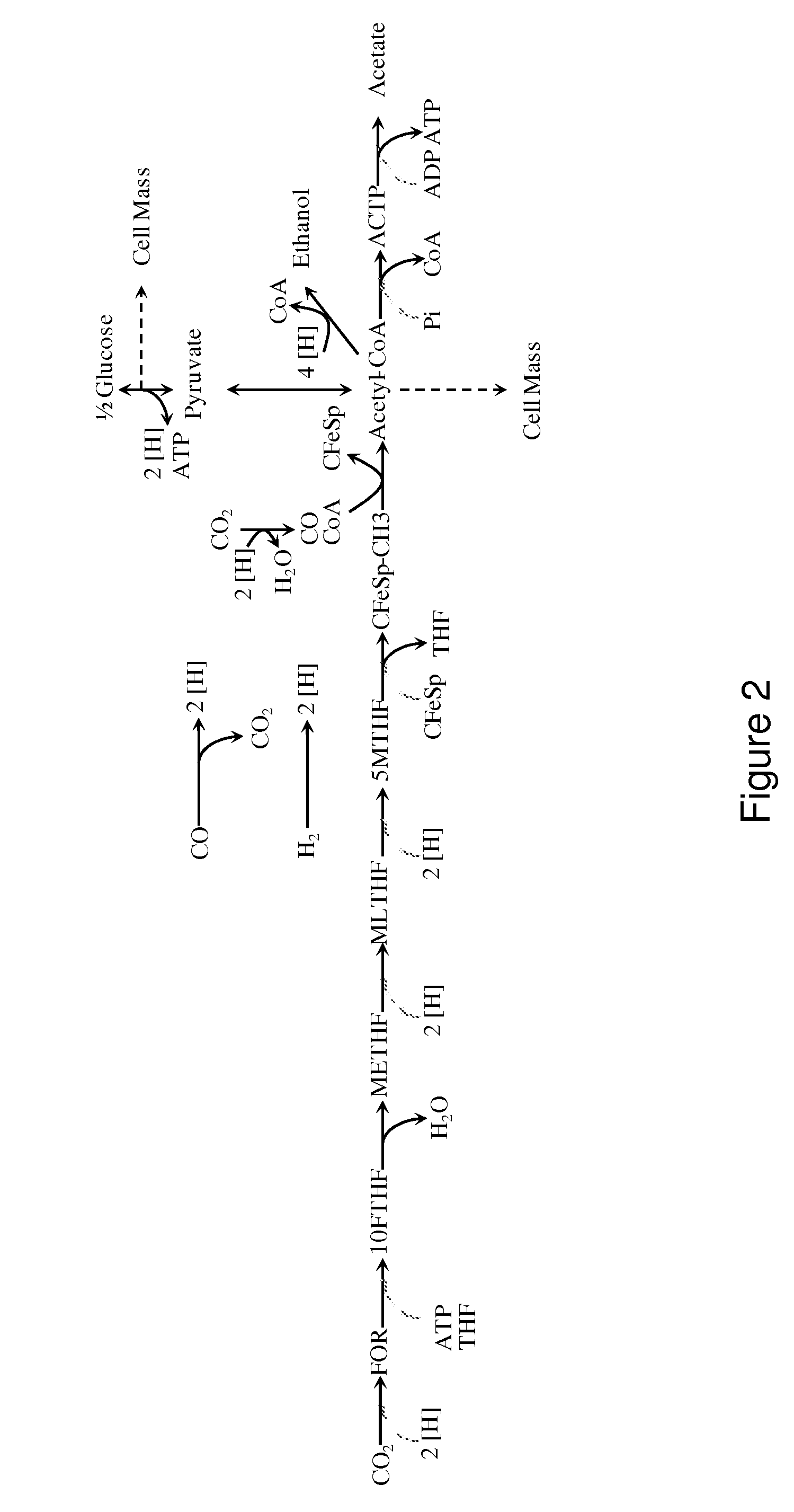Methods and organisms for converting synthesis gas or other gaseous carbon sources and methanol to 1,3-butanediol
a technology of methanol and synthesis gas, applied in the field of biosynthetic processes, can solve the problems of limiting titers and commercialization potential, poorly characterized known organisms, and difficult separation
- Summary
- Abstract
- Description
- Claims
- Application Information
AI Technical Summary
Benefits of technology
Problems solved by technology
Method used
Image
Examples
example i
Production of 1,3-BDO Using Methanol, CO, and / or CO2 as Carbon Feedstock
[0278]This example shows how a non-naturally occurring organism can be constructed to produce 1,3-BDO from methanol, CO, and / or CO2 as the carbon source.
[0279]The first step in the cloning and expression process is to express in E. coli the minimal set of genes (e.g., MtaA, MtaB, and MtaC) necessary to produce Me-THF from methanol. These methyltransferase activities require Coenzyme B12 (cobalamin) as a cofactor. In Moorella thermoacetica, a cascade of methyltransferase proteins mediate incorporation of methanol derived methyl groups into the acetyl-CoA synthase pathway. Recent work (Das et al., Proteins 67.1:167-176 (2007)) indicates that MtaABC are encoded by Moth—1208-09 and Moth—2346. These genes are cloned via proof-reading PCR and linked together for expression in a high-copy number vector such as pZE22-S under control of the repressible PA1-lacO1 promoter (Lutz and Bujard, Nucleic Acids Res. 25.6:1203-121...
example ii
Cloning and Expression of Moorella Thermoacetica ACS / CODH Encoding Genes
[0289]This example describes the creation of E. coli plasmids that express the M. thermoacetica ACS / CODH operon genes including those used for CODH, ACS, methyltransferase, and the corrinoid iron-sulfur protein. This example further describes the expression these in E. coli resulting in observable CO oxidation activity, methyltransferase activity, and corrinoid iron-sulfur protein activity. Finally, this example demonstrates that E. coli tolerates high CO concentrations, and may even consume CO when the CO-utilizing gene products from M. thermoacetica are expressed.
[0290]Expression vectors were chosen from the set described by Lutz and Bujard (Lutz and Bujard, Nucleic Acids Res. 25.6:1203-1210 (1997)); these come with compatible replicons that cover a range of copy numbers. Additionally, each contains prA1-laco1; this T7 early gene promoter is inducible by IPTG and can lead to very high levels of transcription i...
example iii
Enhancing the Yield of 1,3-Butanediol on Sugars with Wood-Ljungdahl Pathway Enzymes
[0309]In this example, we describe a non-naturally occurring microorganism expressing genes encoding enzymes that catalyze the carbonyl-branch of the Wood-Ljungdahl pathway. Wood-Ljungdahl pathway enzymes assimilate carbon in the form of formate, CO and / or CO2 into acetyl-CoA, which can subsequently be converted to useful chemical products such as 1,3-butanediol. The Wood-Ljungdahl pathway can also serve as a secondary carbon assimilation pathway during growth on other substrates such as glucose. Specifically, the conversion of one mole of glucose to two moles of acetyl-CoA generates both reducing equivalents and CO2. The WL pathway enzymes can harness the reducing equivalents to convert the CO2 and / or formate to additional acetyl-CoA that can be further used for 1,3-butanediol formation.
[0310]1,3-Butanediol can be synthesized from acetyl-CoA by several alternate routes described previously in this ap...
PUM
| Property | Measurement | Unit |
|---|---|---|
| temperatures | aaaaa | aaaaa |
| mass | aaaaa | aaaaa |
| time | aaaaa | aaaaa |
Abstract
Description
Claims
Application Information
 Login to View More
Login to View More - R&D
- Intellectual Property
- Life Sciences
- Materials
- Tech Scout
- Unparalleled Data Quality
- Higher Quality Content
- 60% Fewer Hallucinations
Browse by: Latest US Patents, China's latest patents, Technical Efficacy Thesaurus, Application Domain, Technology Topic, Popular Technical Reports.
© 2025 PatSnap. All rights reserved.Legal|Privacy policy|Modern Slavery Act Transparency Statement|Sitemap|About US| Contact US: help@patsnap.com



